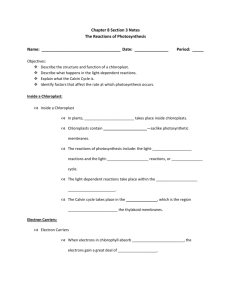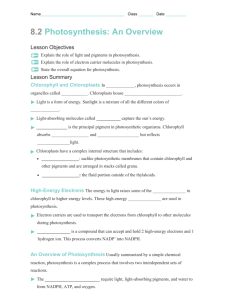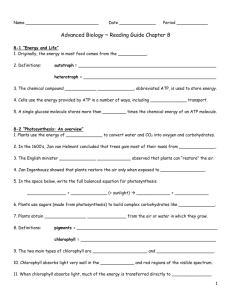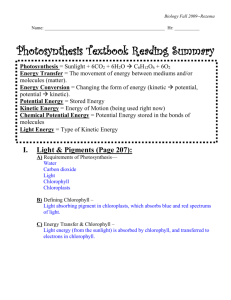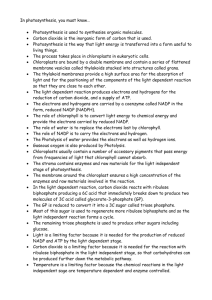Document
advertisement
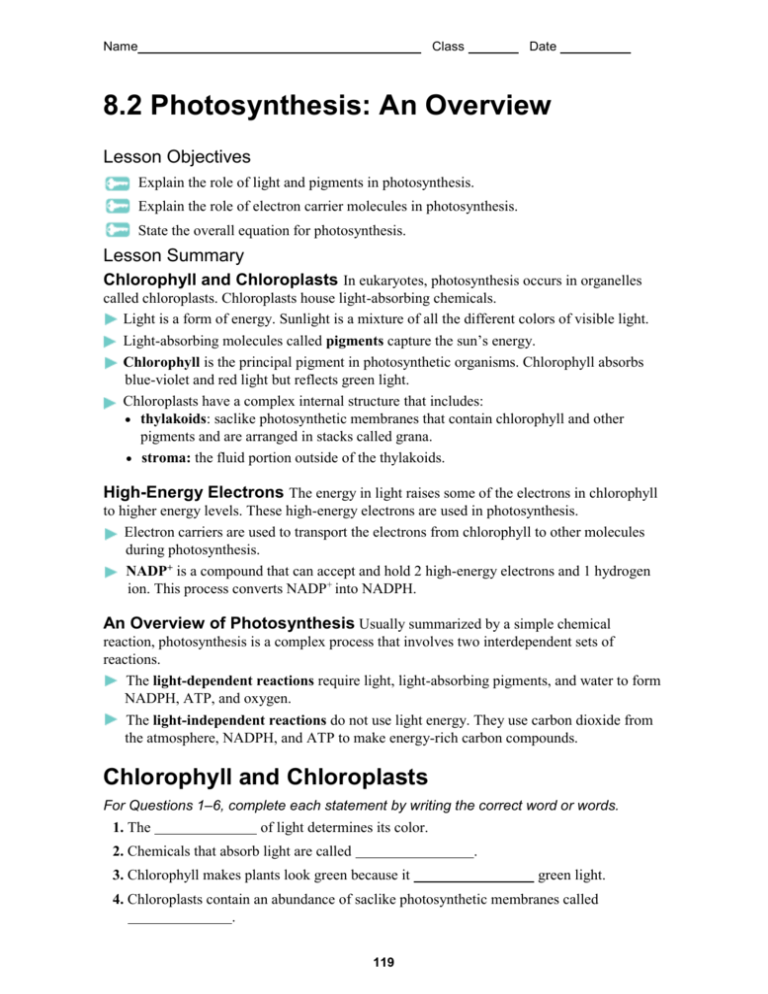
Name Class Date 8.2 Photosynthesis: An Overview Lesson Objectives Explain the role of light and pigments in photosynthesis. Explain the role of electron carrier molecules in photosynthesis. State the overall equation for photosynthesis. Lesson Summary Chlorophyll and Chloroplasts In eukaryotes, photosynthesis occurs in organelles called chloroplasts. Chloroplasts house light-absorbing chemicals. Light is a form of energy. Sunlight is a mixture of all the different colors of visible light. Light-absorbing molecules called pigments capture the sun’s energy. Chlorophyll is the principal pigment in photosynthetic organisms. Chlorophyll absorbs blue-violet and red light but reflects green light. Chloroplasts have a complex internal structure that includes: thylakoids: saclike photosynthetic membranes that contain chlorophyll and other pigments and are arranged in stacks called grana. stroma: the fluid portion outside of the thylakoids. High-Energy Electrons The energy in light raises some of the electrons in chlorophyll to higher energy levels. These high-energy electrons are used in photosynthesis. Electron carriers are used to transport the electrons from chlorophyll to other molecules during photosynthesis. NADP+ is a compound that can accept and hold 2 high-energy electrons and 1 hydrogen ion. This process converts NADP+ into NADPH. An Overview of Photosynthesis Usually summarized by a simple chemical reaction, photosynthesis is a complex process that involves two interdependent sets of reactions. The light-dependent reactions require light, light-absorbing pigments, and water to form NADPH, ATP, and oxygen. The light-independent reactions do not use light energy. They use carbon dioxide from the atmosphere, NADPH, and ATP to make energy-rich carbon compounds. Chlorophyll and Chloroplasts For Questions 1–6, complete each statement by writing the correct word or words. 1. The of light determines its color. 2. Chemicals that absorb light are called . 3. Chlorophyll makes plants look green because it green light. 4. Chloroplasts contain an abundance of saclike photosynthetic membranes called . 119 Name 5. The Class Date is the fluid portion of the chloroplast located outside the thylakoids. 6. The visible light absorbed by chlorophyll chlorophyll’s electrons. the energy level of the 7. THINK VISUALLY Label the internal parts of the chloroplast below. High-Energy Electrons For Questions 8–9, refer to the Visual Analogy comparing electron carriers to oven mitts. 8. VISUAL ANALOG In the visual analogy of carrying electrons, what represents the highenergy electrons? 9. Write another analogy that describes the process of electron carriers. 10. Where do the high-energy electrons carried by NADPH come from? 120 Name Class Date An Overview of Photosynthesis For Questions 11–13, write the letter of the correct answer on the line at the left. 11. What are the reactants of the photosynthesis reaction? A. chlorophyll and light C. carbohydrates and oxygen B. carbon dioxide and water D. high-energy electrons and air 12. What are the products of the light-dependent reactions? A. chloroplasts and light C. oxygen and ATP B. proteins and lipids D. water and sugars 13. Where do the light-independent reactions occur? A. stroma C. chlorophyll B. thylakoids D. mitochondria 14. Complete the illustration by writing the reactants and products of the light-dependent and light-independent reactions. Also, fill in the energy source that excites the electrons. Apply the Big idea 15. Solar power uses cells or panels to absorb the sun’s energy. That energy is then used to create electricity. How does this compare to the light dependent reactions of photosynthesis? 121

